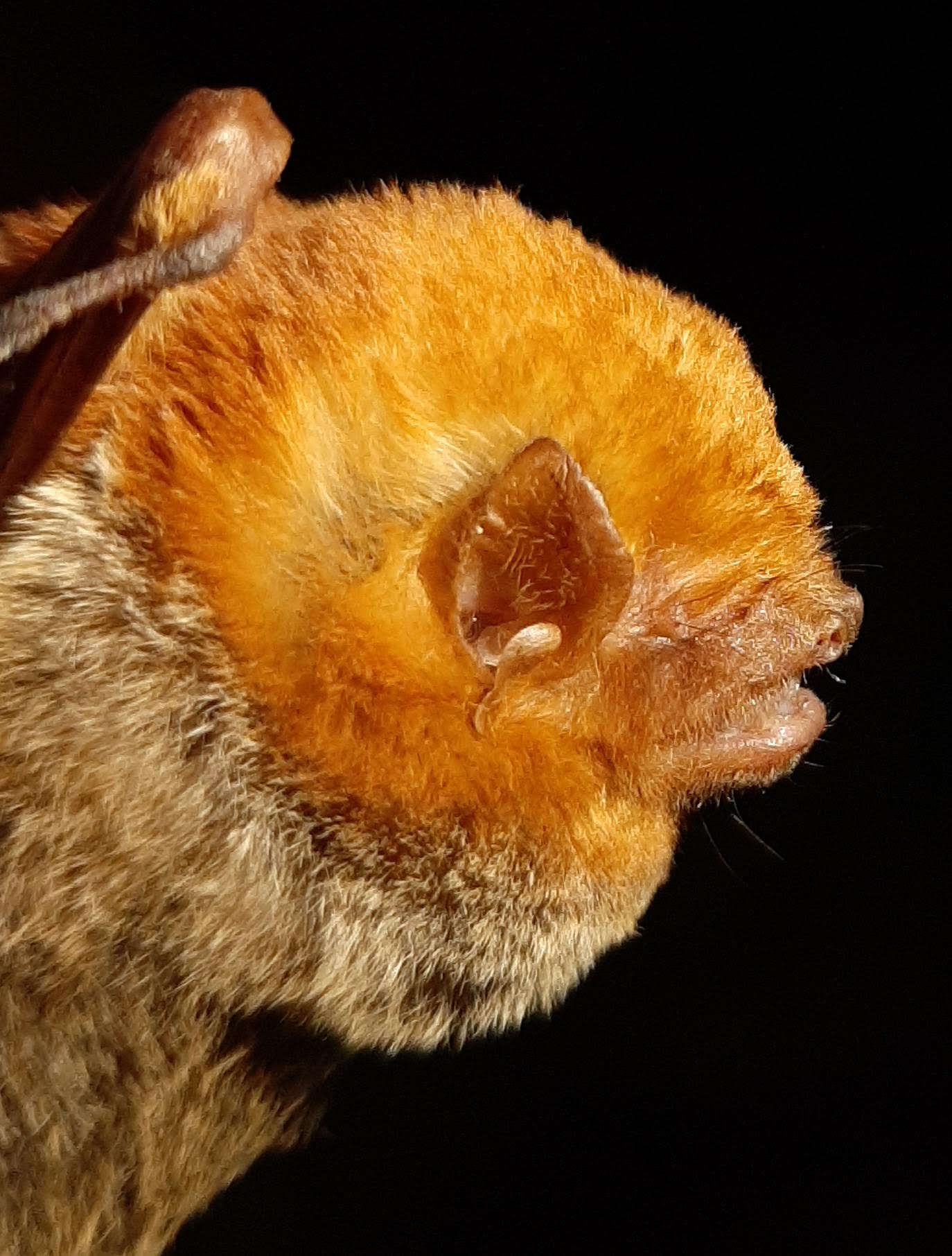Abstract
The diversity of bats that can hosts the protected areas is determined by la habitat quality and the landscape heterogeneity. This quality and heterogeneity are primarily determined by the management. The diversity can indicate us the ecosystem service and goods which can be provided by protected areas. In the case of the bats, these provide some ecosystems services as pollination, seeds dispersion, control of insects population among others. For this reason, with the aim of improving the Management Plan of the Uyuca Biological Reserve, we plan to know the diversity that hosts this site. For this, mist-nets sampling and ultrasonic sound recording techniques were used to have a broad spectrum of the diversity of bats in the area. We identify 25 species of bats, which represents 22% of the diversity of chiroptera reported for Honduras. Three guilds were identified: frugivorous, insectivorous and nectivorous, be insectivorous species having the greatest richness. Our result suggest that Uyuca Biological Reserve hosts a high diversity of bats and fulfills its role in the protection and conservation of bats, as well as their habitat and the ecosystem goods and services that these provide. It is necessary to continue sampling other sectors of the reserve to know more precisely the diversity of chiropterofauna and to carry out population studies of species of conservation interest.
References
Aguilar-Rodríguez, P.A., T. Krömer, M.Tschapka, J.G. García-Franco, J. Escobedo-Sarti y M.C. MacSwiney G. 2019. Bat pollination in Bromeliaceae. Plant Ecology & Divesity, https://doi.org/10.1080/17550874.2019.1566409.
Bordignon, M.O. 2006. Diet of the fishing bat Noctilio leporinus (Linnaeus) (Mammalia, Chiroptera) in a mangrove area of southern Brazil. Revista Brasileira de Zoologia, 23(1):256-260.
Boyles, J.G. P.M. Cryan, G.F. McCracken y T.H. Kunz. 2011. Economic importance of bats in agriculture. Science, 332(6025):41-42.
Cely-Gómez, M.A. y D. Castillo-Figueroa. 2019. Dieto f dominant frugivorous bat species in an oil palm landscape from Colombian Llanos: implications for forest conservation and recovery. Therya, 10(2):149—154.
Cruz, A., F. Cabrera, H. Flores, J. Portillo, W. Alvarado, D. Mejía, K. Lara y C. Funes. 2020. Resultados del taller: “Mejorando las capacidades de investigación de los jóvenes del Programa de Conservación de Murciélagos de Honduras (PCMH)”. Boletín RELCOM 12(2): en prensa.
Cohen, Y., S. Bar-David, M. Nielsen, K. Bohnmann y C. Korine. 2020. An appetite for pests: Synanthropic insectivorous bats exploit cotton pest irruptions and consume various deleterious arthropods. Molecular ecology, 29:1185-1198
Enríquez-Acevedo, T., J. Pérez-Torres, C. Ruiz-Agudelo y A. Suarez. 2020. Seed dispersal by fruit bats in Colombia generates ecosystem services. Agronomy for Sustainable Development, 40:45.
Figueroa-Castillo, D. 2020. Why bats matters: A critical assessment of bat-mediated ecological processes in the neotropics. European Journal of Ecology, 6(1):77-101
Gonsalves, L., B. Law, C. Webb and V. Monamy. 2013. Foraging ranges of insectivorous bats shift relative to changes in mosquito abundance. PlosOne, 8(5): e64081. doi:10.1371/journal.pone.006408
ICF y SERNA. 2009. Plan estratégico del Sistema Nacional de Áreas Protegidas de Honduras (2010-2020). ICF y SERNA, Tegucigalpa, Honduras.
Jones, P.L., F. Hänsch, R. A. Page, E.K.V. Kalko y T.O’Mara. 2017. Foraging and roosting behaviour of the fringe-lipped bat, Trachops cirrhosis, on Barro Colorado Island, Panamá. Acta Chiropterologica, 19(2):337-346.
Kahnonitch, I., Y. Lubin y G. Korine. 2018. Insectivorous bats in semi-arid agroecosystems – effects on foraging actividity and implications for insect pest control. Agriculture, Ecosystems and Environment, 261:80-92.
Kerbiriou, C., C. Azam, J. Touroult, J. Marmet, J. Julien, V. Pellissier. 2018. Common bats are more abundant within Natura 2000 areas. Biological Conservation, 217:66-74.
Librán-Embid, F., G. De Coster y J. P. Metzger. 2017. Effects of bird and bat exclusion on coffee pest control at multiple spatial scale. Landscape Ecology, 32:1907-1920.
Maas, B., Y. Clough y T. Tscharntke. 2013. Bats and birds increase crop yield in tropical agroforestry landscape. Ecology letters, 16:1480-1487.
Maine, J.J. y J.G. Boyles. 2015. Bats initiative vital agroecological interactions in corn. PNAS, 112(40):12438-12443.
Medellín, R.A., H.A. Arita y O. Sánchez H. 2008. Identificación de los murciélagos de México clave de campo. 2a ed., Instituto de Ecología, UNAM. México, D.F.
Miller, B.M. (2003). Community ecology of the non-phyllostomid bats of Northwestern Belize, with a landscape level assessment of the bats of Belize, Ph.D. Thesis. University of Kent Dureell Institute of Conservation and Ecology, UK, p.293.
Mora, J.M. 2016. Clave para la identificación de las especies de murciélago de Honduras. Ceiba, 54:93-117.
Mullin, K.; N. Yoh; S. L. Mitchell, S. Basrur, D.J.I. Seaman, H. Bernard y M.J. Struebig. 2020. Riparian reserves promote insectivorious bat activity in oil plan dominated landscapes. Frontiers in Forests and Global Change, 3:1-12.
Nurfatiha, S. N. Fakhrul-hatta, B. Raveen Nelson, N. J. Shafie, M.A. Zahidin, M.T. Abdullah. 2018. Linkages between chisopteran diversity and ecosystem services for sustainable fragmented forest conservation. Journal Data in Brief, 21:2089-2094.
Oprea, M., C.E.L. Esbérard, T.B. Vieira, P. Mednes, V.T. Pimenta, D. Brito y A.D. Ditchfield. 2009. Bat community species richness and composition in a restinga protected ares in Southeastern Brazil. Brazilian Journal of Biology, 69(4):1073-1079.
Regolin, A.L., R.L. Muylaert, A.C. Crestani, W. Dáttilo y M. C. Ribeiro. 2020. Seed dispersal, by neotropical bats in human-disturbed landscape. Wildlife Research 48(1):A-F.
Ribeiro Mello, M., F.M. Darcie Marquitti, P. R. Guimarães Jr., E. K. Viktoria Kalko, P. Jodano y M.a. Martinez de Aguiar. 2011. The missing part of seed dispersal networks: structure androbustness of bat-fruit interactions. PlosOne, 6(2): e17395.
Rodríguez-San Pedro, A., J. L. Allendes. C. A. Beltrán, P.N. Chaperon, M.M. Saldarriaga-Córdoba, A.X. Silva y A.A. Grez. Quantifying ecological and economic value of pest control services provided by bats in a vineyard landscape of central Chile. Agriculture, Ecosystems and Environment, 302(107063):1-9.
Silva, I., R. Rocha, A. López-Baucells, F.Z. Ferneda y C.E.J. Meyer. 2020. Effect of forest fragmentation on the vertical stratification of Neotropical bats. Diversity, 12(67):1-15
Stewart, A.B. y M.R. Dudash. 2016. Flower-visiting bat species contribute unequally toward agricultural pollination ecosystem services in southern Thailand. Biotropica, 49 (2): 1-23.
Tremlett, C.J., M. Moore, M.A. Chapman, C.Zamora-Gutierrez y K.S.H. Peh. 2019. Pollination by bats enhances both quality and yield of a major cash crop in México. Journal of Applied Ecology, 57:450-459.
Turcios-Casco, M.A., H.D. Ávila-Palma, R.K. LaVal, R.D. Stevens, E.J Ordoñez-Trejo, J.A. soler-Orellana, D.I. Ordoñez-Mazier. 2020. A systematic revision of the bats (Chiroptera) of Honduras: an updated checklist with corroboration of historical specimens and new records. Zoosystematics and Evolution,92:411-429.
Universidad Zamorano e ICF. 2020. Plan de Manejo de la Reserva Biológica Uyuca (2020 – 2032). Centro Zamorano de Biodiversidad, Departamento de Ambiente y Desarrollo, Universidad Zamorano, San Antonio de Oriente; e ICF, Región Forestal Fco. Morazán, Oficina Regional Tegucigalpa.
Vehrencamp,, S., F. Gary Stiles y J.W. Brandbury. 1977. Observations on the Foraging Behavior and Avian Prey of the Neotropical Carnivorous Bat, Vampyrum spectrum. Mammalogy, 58(4):469-478.
Vicente-Santos, A., A. Moreira-Soto, C. Soto-Garita, L.G. Chaverri, A. Chaves, J.F. Drexler, J.A. Morales, A. Alfaro-Alarcón, B. Rodríguez-Herrera, E. Corrales-Aguilar. 2017. Neotropical bats that co-habit with humans function dead-end hosts for dengue virus. Plos Neglrected Tropical Diseases 11(5): e0005537.

This work is licensed under a Creative Commons Attribution-NonCommercial-NoDerivatives 4.0 International License.
Copyright (c) 2021 Revista Mexicana de Mastozoología (nueva época)



